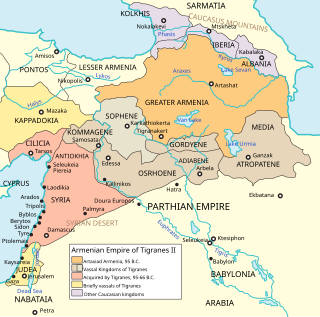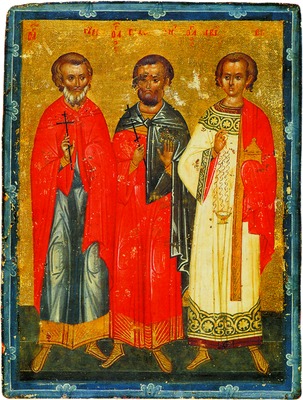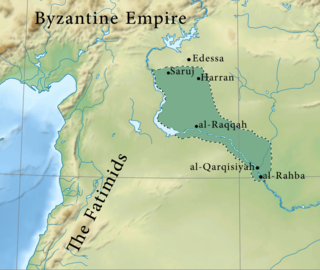Related Research Articles
Cyrus is a male given name. It is the given name of a number of Persian kings. Most notably it refers to Cyrus the Great. Cyrus is also the name of Cyrus I of Anshan, King of Persia and the grandfather of Cyrus the Great; and Cyrus the Younger, brother to the Persian King Artaxerxes II of Persia.

The First Crusade (1096–1099) was the first of a series of religious wars, or Crusades, initiated, supported and at times directed by the Latin Church in the medieval period. The objective was the recovery of the Holy Land from Islamic rule. While Jerusalem had been under Muslim rule for hundreds of years, by the 11th century the Seljuk takeover of the region threatened local Christian populations, pilgrimages from the West, and the Byzantine Empire itself. The earliest initiative for the First Crusade began in 1095 when Byzantine emperor Alexios I Komnenos requested military support from the Council of Piacenza in the empire's conflict with the Seljuk-led Turks. This was followed later in the year by the Council of Clermont, during which Pope Urban II supported the Byzantine request for military assistance and also urged faithful Christians to undertake an armed pilgrimage to Jerusalem.

Osroene or Osrhoene was an ancient region and state in Upper Mesopotamia. The Kingdom of Osroene, also known as the "Kingdom of Edessa", according to the name of its capital city, existed from the 2nd century BC, up to the 3rd century AD, and was ruled by the Abgarid dynasty. Generally allied with the Parthians, the Kingdom of Osroene enjoyed semi-autonomy to complete independence from the years of 132 BC to AD 214. Though ruled by a dynasty of Arab origin, the kingdom's population was of mixed culture, being Syriac-speaking from the earliest times. The city's cultural setting was fundamentally Syriac, alongside strong Greek and Parthian influences, though some Arab cults were also attested at Edessa.

The Principality of Antioch was one of the Crusader states created during the First Crusade which included parts of modern-day Turkey and Syria. The principality was much smaller than the County of Edessa or the Kingdom of Jerusalem. It extended around the northeastern edge of the Mediterranean, bordering the County of Tripoli to the south, Edessa to the east, and the Byzantine Empire or the Kingdom of Armenia to the northwest, depending on the date.

Edessa was an ancient city (polis) in Upper Mesopotamia, in what is now Urfa, Turkey. It was founded during the Hellenistic period by King Seleucus I Nicator, founder of the Seleucid Empire. It later became capital of the Kingdom of Osroene, and continued as capital of the Roman province of Osroene. In Late Antiquity, it became a prominent center of Christian learning and seat of the Catechetical School of Edessa. During the Crusades, it was the capital of the County of Edessa.
The Three-Chapter Controversy, a phase in the Chalcedonian controversy, was an attempt to reconcile the non-Chalcedonians of Syria and Egypt with Chalcedonian Christianity, following the failure of the Henotikon. The Three Chapters that Emperor Justinian I anathematized were:
- The person and writings of Theodore of Mopsuestia
- Certain writings of Theodoret of Cyrus
- The letter of Ibas of Edessa to Maris

The Battle of Harran took place on 7 May 1104 between the Crusader states of the Principality of Antioch and the County of Edessa, and the Seljuk Turks. It was the first major battle against the newfound Crusader states in the aftermath of the First Crusade, marking a key turning point against Frankish expansion. The battle had a disastrous effect on the Principality of Antioch as the Turks regained territory earlier lost.

Cyrus II of Persia, commonly known as Cyrus the Great, was the founder of the Achaemenid Persian Empire. Hailing from Persis, he brought the Achaemenid dynasty to power by defeating the Median Empire and embracing all of the previous civilized states of the ancient Near East, expanding vastly and eventually conquering most of West Asia and much of Central Asia to create the world's then-largest polity. The Achaemenid Empire's largest territorial extent was achieved under the rule of Cyrus' successor Darius the Great, whose rule stretched from the Balkans and the rest of Southeast Europe in the west to the Indus Valley in the east.

Abibus of Edessa, also known as Abibus the New, Habib the Deacon or Saint Habibus the Martyr, was a 4th-century Syrian Christian deacon, confessor and martyr, who according to the Martyrdom of Habib the Deacon, was executed at Edessa by immolation under Roman Emperor Licinius. He is venerated as a saint by the Catholic, Eastern Orthodox and Oriental Orthodox Churches.
The Battle of Opis was the last major military engagement between the Achaemenid Persian Empire and the Neo-Babylonian Empire, which took place in September 539 BC, during the Persian invasion of Mesopotamia. At the time, Babylonia was the last major power in Western Asia that was not yet under Persian control. The battle was fought in or near the strategic riverside city of Opis, located north of the capital city of Babylon in modern-day Iraq, and resulted in a decisive victory for Persia. Shortly afterwards, the Babylonian city of Sippar surrendered to Persian forces, who then supposedly entered Babylon without facing any further resistance. The Persian king Cyrus the Great was subsequently proclaimed as the king of Babylonia and its subject territories, thus ending its independence and incorporating the entirety of the fallen Neo-Babylonian Empire into the greater Achaemenid Empire.

The fall of Babylon was the decisive event that marked the total defeat of the Neo-Babylonian Empire to the Achaemenid Persian Empire in 539 BCE.
Cyrus II was the archbishop of Edessa and metropolitan of Osrhoene from 471 until his death.

The Numayrids were an Arab dynasty based in Diyar Mudar. They were emirs (princes) of their namesake tribe, the Banu Numayr. The senior branch of the dynasty, founded by Waththab ibn Sabiq in 990, ruled the Euphrates cities of Harran, Saruj and Raqqa more or less continuously until the late 11th century. In the early part of Waththab's reign, the Numayrids also controlled Edessa until the Byzantines conquered it in the early 1030s. In 1062, the Numayrids lost Raqqa to their distant kinsmen and erstwhile allies, the Mirdasids, while by 1081, their capital Harran and nearby Saruj were conquered by the Turkish Seljuks and their Arab Uqaylid allies. Numayrid emirs continued to hold isolated fortresses in Upper Mesopotamia, such as Qal'at an-Najm and Sinn Ibn Utayr near Samosata until the early 12th century, but nothing is heard of them after 1120.
The Acts of Shmona and of Gurya is a Syriac Christian martyrdom text. The setting takes place at Edessa during Roman Emperor Diocletian's Great Persecution.

2 Chronicles 36 is the thirty-sixth chapter of the Second Book of Chronicles the Old Testament of the Christian Bible or of the second part of the Books of Chronicles in the Hebrew Bible. The book is compiled from older sources by an unknown person or group, designated by modern scholars as "the Chronicler", and had the final shape established in late fifth or fourth century BCE. This chapter belongs to the section focusing on the kingdom of Judah until its destruction by the Babylonians under Nebuchadnezzar and the beginning of restoration under Cyrus the Great of Persia. It contains the regnal accounts of the last four kings of Judah - Jehoahaz, Jehoiakim, Jehoiachin and Zedekiah - and the edict of Cyrus allowing the exiled Jews to return to Jerusalem.
The Chronicle of Edessa is an anonymous history of the city of Edessa written in the mid-6th century in the Syriac language. "Chronicle of Edessa" is a conventional title; in the manuscript it is titled Histories of Events in Brief.
Euphemia and the Goth is a romance text of Syriac literature. It is set at Edessa in Mesopotamia in 396 AD but the story appears to have been written in the fifth century AD. The text is known to have survived in two Syriac manuscripts and in a Greek translation.
Cyrus of Edessa was a Syriac writer and teacher in the Church of the East. He was probably a native of Edessa. He studied at the school of Nisibis under Aba, the future patriarch, and then taught at the school of Seleucia-Ctesiphon, eventually rising to become its headmaster. He founded a monastery at Ḥirta sometime after the death of Aba (552).
Basil bar Shumna was the Syriac Orthodox metropolitan archbishop of Edessa from 1143 until his death. He wrote a Syriac chronicle covering the years from 1118 until his death, which is now lost but was used as a source by Michael the Great and the anonymous author of the Chronicle of 1234.
The siege of Edessa in October–November 1146 marked the permanent end of the rule of the Frankish Counts of Edessa in the city on the eve of the Second Crusade. It was the second siege the city had suffered in as many years, the first siege of Edessa having ended in December 1144. In 1146, Joscelyn II of Edessa and Baldwin of Marash recaptured the city by stealth but could not take or even properly besiege the citadel. After a brief counter-siege, Zangid governor Nūr al-Dīn took the city. The population was massacred and the walls razed. This victory was pivotal in the rise of Nūr al-Dīn and the decline of the Christian city of Edessa.
References
- 1 2 3 Benjamin Harris Cowper, ed. (1865), "The Chronicle of Edessa", Journal of Sacred Literature and Biblical Record, 5 (9), pp. 28–45, at 83.
- ↑ Susan Ashbrook Harvey (2005), "'Incense in Our Land': Julian Saba and Early Christianity", in R. S. Sugirtharajah (ed.), Wilderness: Essays in Honour of Frances Young, T&T Clark, pp. 120–134, at 124.
- ↑ F. C. Burkitt, ed. (1913), Euphemia and the Goth, with the Acts of Martyrdom of the Confessors of Edessa, Williams and Norgate, p. 58.